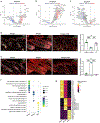Dynamic regulation of chromatin accessibility during melanocyte stem cell activation
- PMID: 37462349
- PMCID: PMC10794558
- DOI: 10.1111/pcmr.13112
Dynamic regulation of chromatin accessibility during melanocyte stem cell activation
Abstract
Melanocyte stem cells (McSCs) of the hair follicle are necessary for hair pigmentation and can serve as melanoma cells of origin when harboring cancer-driving mutations. McSCs can be released from quiescence, activated, and undergo differentiation into pigment-producing melanocytes during the hair cycle or due to environmental stimuli, such as ultraviolet-B (UVB) exposure. However, our current understanding of the mechanisms regulating McSC stemness, activation, and differentiation remains limited. Here, to capture the differing possible states in which murine McSCs can exist, we sorted melanocyte nuclei from quiescent (telogen) skin, skin actively producing hair shafts (anagen), and skin exposed to UVB. With these sorted nuclei, we then utilized single-nucleus assay for transposase-accessible chromatin with high-throughput sequencing (snATAC-seq) and characterized three melanocyte lineages: quiescent McSCs (qMcSCs), activated McSCs (aMcSCs), and differentiated melanocytes (dMCs) that co-exist in all three skin conditions. Furthermore, we successfully identified differentially accessible genes and enriched transcription factor binding motifs for each melanocyte lineage. Our findings reveal potential gene regulators that determine these melanocyte cell states and provide new insights into how aMcSC chromatin states are regulated differently under divergent intrinsic and extrinsic cues. We also provide a publicly available online tool with a user-friendly interface to explore this comprehensive dataset, which will provide a resource for further studies on McSC regulation upon natural or UVB-mediated stem cell activation.
Keywords: UVB; melanocyte stem cells; single-nucleus ATAC-sequencing; skin.
© 2023 John Wiley & Sons A/S. Published by John Wiley & Sons Ltd.
Figures




References
-
- Adam RC, Yang H, Ge Y, Infarinato NR, Gur-Cohen S, Miao Y, Wang P, Zhao Y, Lu CP, Kim JE, Ko JY, Paik SS, Gronostajski RM, Kim J, Krueger JG, Zheng D, Fuchs E, 2020. NFI transcription factors provide chromatin access to maintain stem cell identity while preventing unintended lineage fate choices. Nat. Cell Biol. 22, 640–650. doi:10.1038/s41556-020-0513-0 - DOI - PMC - PubMed
Publication types
MeSH terms
Substances
Associated data
- Actions
- Actions
- Actions
- Actions
Grants and funding
LinkOut - more resources
Full Text Sources

